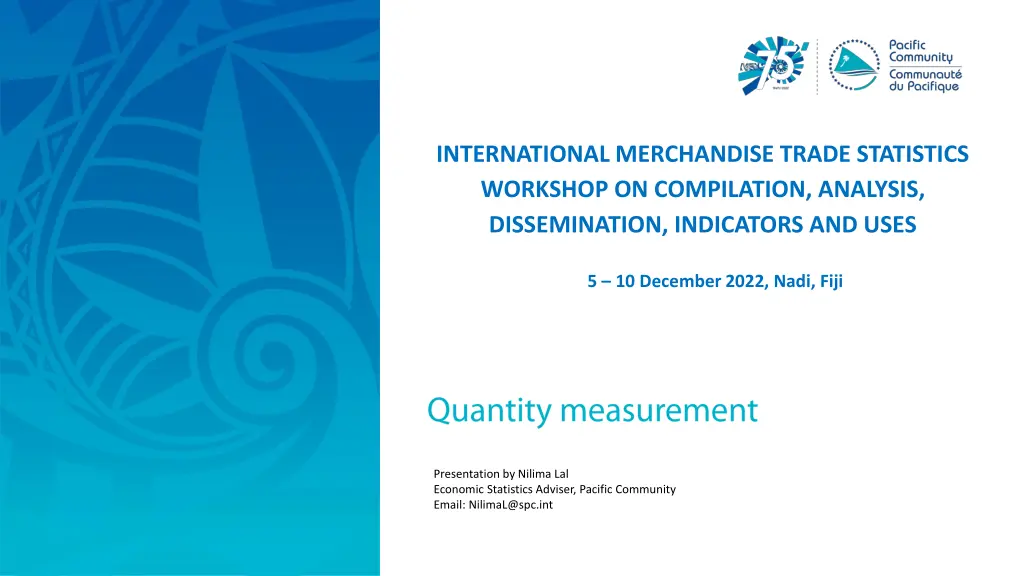
Insights into International Merchandise Trade Statistics and Quantity Units
Gain valuable insights into international merchandise trade statistics, the importance of quantity units, and the use of gross vs. net weight in global trade. This workshop presentation covers the significance of quantity measurements, recommended standard units, and the role of quantity units in enhancing the reliability and accuracy of trade data. Learn about the different applications of quantity units in trade analysis, infrastructure planning, food balance calculations, and environmental impact assessments.
Download Presentation

Please find below an Image/Link to download the presentation.
The content on the website is provided AS IS for your information and personal use only. It may not be sold, licensed, or shared on other websites without obtaining consent from the author. If you encounter any issues during the download, it is possible that the publisher has removed the file from their server.
You are allowed to download the files provided on this website for personal or commercial use, subject to the condition that they are used lawfully. All files are the property of their respective owners.
The content on the website is provided AS IS for your information and personal use only. It may not be sold, licensed, or shared on other websites without obtaining consent from the author.
E N D
Presentation Transcript
INTERNATIONAL MERCHANDISE TRADE STATISTICS WORKSHOP ON COMPILATION, ANALYSIS, DISSEMINATION, INDICATORS AND USES 5 10 December 2022, Nadi, Fiji Presentation by Nilima Lal Economic Statistics Adviser, Pacific Community Email: NilimaL@spc.int
Quantity units Quantity units Quantity units refer to the physical characteristics of goods. They are free of valuation problems therefore provide a more reliable indicator of international movements of goods. Differences in quantity measurements between the importing country and the exporting country are normally less significant than in value measurements so data by quantity traded between the importing and exporting countries are more comparable. 12/06/2025 2 2
Need for quantity units checking the reliability of the value data by calculating unit values (value divided by quantity); the construction of international trade index numbers (the import and export price indexes that can then be used to calculate the terms of trade); planning transport infrastructure; the calculation of food balances how much of what food (balanced diet) should be imported based on a country s production and population; and assessing the impact of international trade on environment. 3
WCO recommended standard units of quantity WCO recommended standard units of quantity WCO standard units of quantity should be used Weight figures should be reported on a net weight basis (exclusive of the container, internal wrapping, or any other packaging). However, if only gross weight is available, it should be recorded and used for the estimation of net weight. Countries that use units of quantity other than the WCO standard units need to provide the conversion factors to the standard units in their statistical nomenclatures. 4
Gross weight vs net weight Gross weight includes packaging but excludes the carrier s equipment. Net weight does not include any packing except where the packaging itself is also a good e.g. a silver caddy containing tea; an ornamental ceramic bowl containing sweets; and packing materials or packing containers clearly suitable for repetitive use, such as metal drums or containers of iron or steel for compressed or liquefied gas. Each measurement meets a different need. Gross weight is appropriate for the analysis of transportation Net weight is useful for economic analysis, such as identifying the nutritional or caloric content of imported food items. 5
Challenges in the compilation of the quantities Frequent issues with quantity data are: missing quantity data, incorrect quantity data, and Possible causes related to the issues include: when a shipment contains several different commodities, its quantity is often given as the gross weight of the shipment; the use of not-recommended quantity units in commercial practice; and emphasis of customs on value data (especially of imports). 6
Improving the compilation of quantity data at the Improving the compilation of quantity data at the source source When training traders on how to fill in customs declarations (such as SAD), customs administrations need to stress the importance of traders providing the recommended quantity information. 7
Recommendation Recommendation It is recommended that PICTs collect or estimate, validate and report quantity information in WCO standard units of quantity and in net weight on all trade transactions. 8
